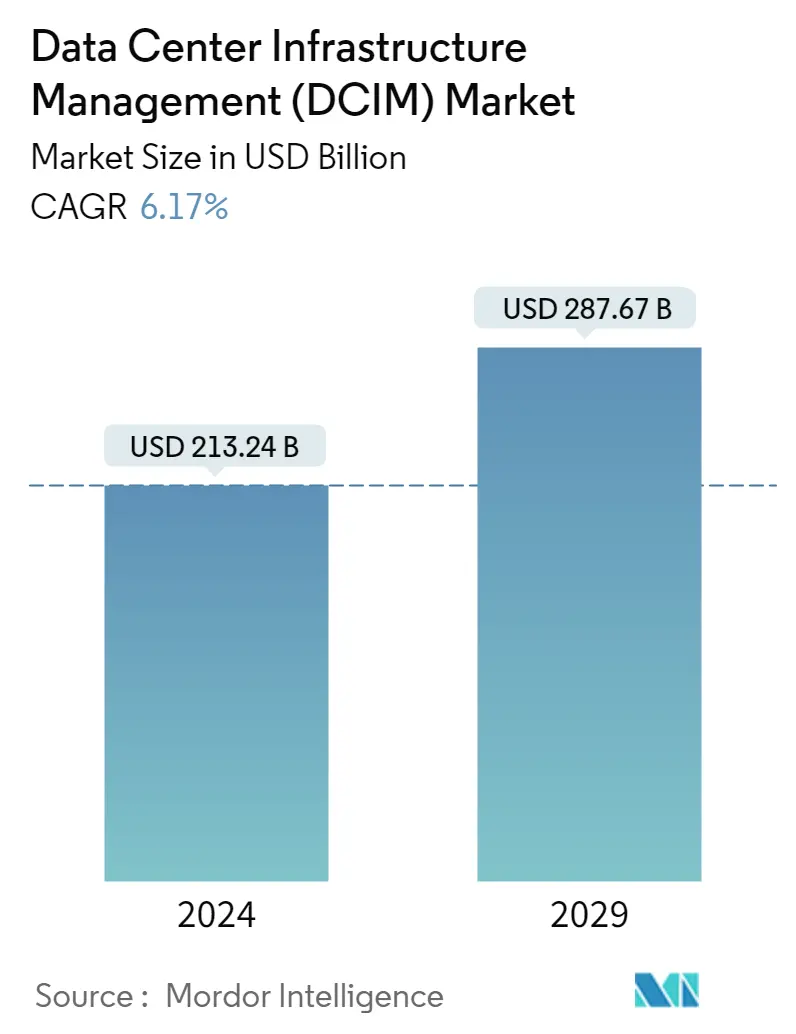Market Size of Data Center Infrastructure Management (DCIM) Industry

| Study Period | 2019 - 2029 |
| Market Size (2024) | USD 213.24 Billion |
| Market Size (2029) | USD 287.67 Billion |
| CAGR (2024 - 2029) | 6.17 % |
| Fastest Growing Market | Asia Pacific |
| Largest Market | North America |
Major Players_Market_-_Major_Players.webp)
*Disclaimer: Major Players sorted in no particular order |
Need a report that reflects how COVID-19 has impacted this market and its growth?
Data Center Infrastructure Management Market Analysis
The Data Center Infrastructure Management Market size is estimated at USD 213.24 billion in 2024, and is expected to reach USD 287.67 billion by 2029, growing at a CAGR of 6.17% during the forecast period (2024-2029).
Due to the Covid-19 pandemic, challenges concerning the construction of new data center capacity have risen. Most vendors are postponing or canceling projects or activities, which could increase the risk of infection. As per Vantage, construction being stalled is inevitable as multiple workers move around building sites, making the social-distancing rules hard to implement instead of ensuring staff safety.
- The need to manage limited space and high rack densities to reduce IT system downtime has driven the data center infrastructure management (DCIM) market's growth for the past few years.
- According to AFCOM estimates, the current rack density is valued at 16.9 kW in data centers. According to a data Centers Association (AFCOM) study, close to 67% reported increased rack density in the past three years. Moreover, the study highlights that with an average power density of about 7 kilowatts per rack, most data centers face challenges in managing their IT workloads with traditional air-cooling methods.
- 5G is expected to play a crucial role in supporting governments and policymakers to transform their cities into smart cities, allowing citizens to realize and partake in the socio-economic benefits of an advanced, data-intensive digital economy. Therefore, policymakers must construct and upgrade passive assets like fiber networks and data centers.
- Factors driving the rack density include the growth of cloud computing, Big Data, and AI. It is essential to manage IT since more equipment fits into the data center space. Such facts indicate the need for solutions such as DCIM.
- The increasing demand for cloud and data traffic moving from and within the data centers is expected to bolster the market's growth over the forecast period. According to Cisco Systems, the cloud data center IP traffic is expected to reach 19,509 exabytes per year by 2021, compared to 1,046 exabytes per year of traditional data center traffic.
- Vendors in the market are allowing API integration into DCIM solutions. Overall, the increasing data volumes in the cloud, edge data centers, data center consolidation, etc., are likely to shape data center infrastructure management.
- In April 2022, Compass Datacenters, an American colocation behemoth, formed a business segment named Compass Quantum to sell modular data centers as a service. Each module has enough room, power, and cooling to support 100kW of IT equipment in a two-node redundant arrangement. Quantum can handle site selection, permitting, building, and even facility upkeep as part of the service. If the data center is no longer needed, it will be packed up, refurbished, and sent to another location. Most importantly, rather than making an upfront capital investment, consumers can pay for their white space over the course of 7-10 years through operational expenses. When the initial contract expires, they will have the option to purchase the data center.
- The data center sector has been changing for a long time, but the last several years have been particularly challenging, mainly owing to the COVID-19 pandemic. At first, it may have appeared that all these changes were being made to accommodate stay-at-home orders on temporarily, but that is no longer the case. The surge in remote school and work, making business calls on Zoom instead of the phone, and utilizing an app for everything seems to be a permanent trend.
